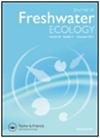水位变化对沉水植物苦草形态和生理的影响
IF 1.3
4区 环境科学与生态学
Q3 ECOLOGY
引用次数: 1
摘要
摘要为了研究苦草的形态和生理对水位变化的响应,将幼苗放置在50米以下的水中 厘米至135 cm,并分别设定上升和下降水位(0.2 cm/d,0.5 cm/d,0.8 cm/d,1.1 cm/d,1.4 cm/d,1.7 cm/d)。50后 通过天的模拟实验,我们观察了叶片数、根活性、生物量、叶绿素a、叶绿素b、叶绿素a + b) (叶绿素a + b) 、类胡萝卜素(Car)、可溶性蛋白(SP)和可溶性糖(SS)。结果表明:(1)在高水位变化率条件下,株高和叶片数总体呈上升趋势,而低水位变化率则呈先升后降的趋势。(2) 0.5–1.7的根系活性 cm/d组在水位上升时随试验时间的增加而增加,水位下降时呈先上升后下降的趋势。总生物量随试验时间的延长呈上升趋势。(3) Chl a、Chl b、Chl(a + b) ,随着测试时间的延长,Car呈现多峰下降趋势。(4) SP和SS对试验时间的响应随水位变化呈先增加后减少的趋势。总之,我们的研究表明,游泳池的形态和生理可以适应水位的变化,但如果水位超过合适的范围,它可能会受到胁迫。本文章由计算机程序翻译,如有差异,请以英文原文为准。
Effects of water level changes on the morphological and physiology of the submerged macrophyte Vallisneria natans
Abstract To study the response of the Vallisneria natans morphological and physiology to water level change, seedlings were placed in a submerged condition at depths ranging from 50 cm to 135 cm and set the rising and declining water levels respectively (0.2 cm/d, 0.5 cm/d, 0.8 cm/d, 1.1 cm/d, 1.4 cm/d, 1.7 cm/d). After 50 days of simulation experiment, we observed the effects on plant height, the number of blades, root activity, biomass, chlorophyll a (Chl a), chlorophyll b (Chl b), chlorophyll (a + b) (Chl a + b), carotenoid (Car), soluble protein (SP) and soluble sugar (SS) of V. natans under different water level change rates. The results showed that (1) plant height and the number of blades showed an overall upward trend under the condition of high-rate water level change, while the low-rate change of water level showed a trend of first rising and then decreasing. (2) the root activity of 0.5–1.7 cm/d groups increased with the test time at rising water level, and the declining water level showed a trend of increasing and then decreasing. The total biomass showed an upward trend with the extension of the test time. (3) Chl a, Chl b, Chl (a + b), and Car showed a multi-peak downward trend with the extension of the test time. (4) the response of SP and SS to the test time showed a trend of first increase and then decrease with water level changes. In conclusion, our study demonstrates that the morphological and physiology of V. natans could adapt to water level changes, but it could be stressed if the water level exceeded the suitable range.
求助全文
通过发布文献求助,成功后即可免费获取论文全文。
去求助
来源期刊
CiteScore
2.20
自引率
7.70%
发文量
34
审稿时长
3 months
期刊介绍:
The Journal of Freshwater Ecology, published since 1981, is an open access peer-reviewed journal for the field of aquatic ecology of freshwater systems that is aimed at an international audience of researchers and professionals. Its coverage reflects the wide diversity of ecological subdisciplines and topics, including but not limited to physiological, population, community, and ecosystem ecology as well as biogeochemistry and ecohydrology of all types of freshwater systems including lentic, lotic, hyporheic and wetland systems. Studies that improve our understanding of anthropogenic impacts and changes to freshwater systems are also appropriate.

 求助内容:
求助内容: 应助结果提醒方式:
应助结果提醒方式:


